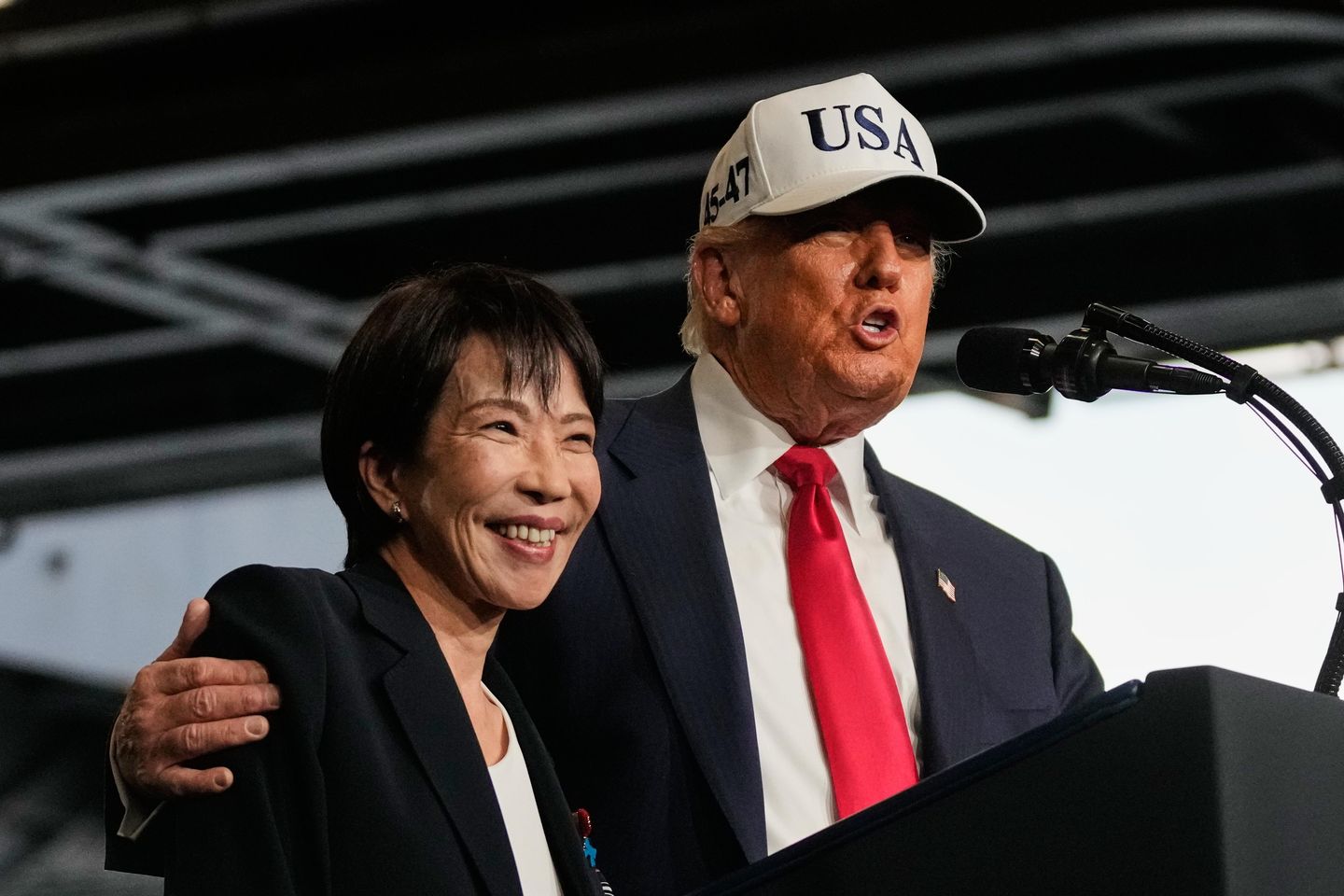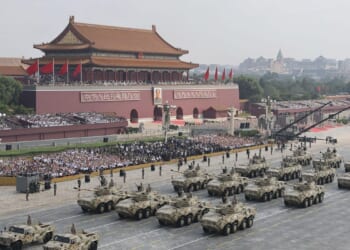
SEOUL, South Korea — New Prime Minister Sanae Takaichi talked up defense spending and got along famously with President Trump on his recent Asian tour, but delivering on her promise to rearm Japan is far from assured, even with growing concerns in Tokyo about China, North Korea and Russia.
Reaction in Japan to last week’s meeting between the two leaders has been generally positive, but some analysts warn that Tokyo’s ongoing rearmament drive may be not viable, due to the nation’s economic, demographic and spiritual malaise.
“Japan cannot sustain the remilitarization agenda being proposed,” said Koichi Nakano, a political science professor at Japan’s Sophia University.
Plans to accelerate defense spending from 1.4% of gross domestic product in 2024 — itself a 21% annual increase — to 2% on defense “is not going to go down very well with elderly voters,” he said, due to the concurrent drop likely required in social security spending amid an aging populace.
Mr. Nakano, formerly a visiting scholar working on U.S.-Japan relations at Harvard University, spoke Tuesday on Japan’s Security Policy in a New Era of Geopolitical Tensions, a webinar hosted by the Daiwa Anglo-Japanese Foundation.
He warned that aspirations among some politicians that Japan can “punch above its weight” should “not be taken very seriously,” due to falling capacities.
Japan Inc.’s industrial glories are fading, as it fails to identify new growth engines.
Once the world’s second-largest economy, it fell to third, behind China, in 2010, then to fourth, behind Germany, in 2024, and may drop to fifth, behind India, next year.
Japan’s population peaked in 2008 at 128 million, but now stands at 123 million, and the decline continues. This presents the Self Defense Forces with a “structural challenge” on recruitment, according to the Brookings Institute.
Brookings found that Japan’s core recruitment demographic — people aged 18-26 — fell from 17.43 million in 1994, to 10.2 million in 2024, and will hit 9.17 million in 2034.
These factors impact war-making ability — most particularly against China.
“When you talk of big-power wars, they will not end overnight,” Mr. Nakano said. “How can Japan sustain combat against a continental power it could not win [against] in the 1940s?”
He said Japan’s biggest vulnerabilities in a potential showdown with nuclear-armed China include a nationwide network of nuclear reactors and inferior economic and human resource bases.
There is also, he said, the matter of whether Japan is willing to fight, even in defense of Taiwan, the one Asian polity that retains fond memories of Japanese imperialism. For that reason, it is greatly loved by many Japanese — not least, its new premier.
“Team Takaichi is really keen on Taiwan,” Mr. Nakano said.
Still, empty assurances may be in play.
“Politicians and retired Self-Defense Force members keep visiting Taiwan and telling them Japan is committed to their rescue but there is no consensus, or even a scenario,” Mr. Nakano said.
A source familiar with regional arms commerce told The Washington Times that “Japan would be in it from Day 1” — the assumption being, China would strike Japan preemptively if it ever invaded Taiwan.
Mr. Nakano differed. “I would not tell Taiwanese friends that Japan will come to the rescue,” he said.
It is unclear whether his opinions represent overall Japanese thinking. The public is neither protesting rearmament nor pushing back on deterring China, North Korea and Russia.
“It is so hard to gauge what people think; public opinion is so malleable,” he admitted. “Japanese people love the U.S., no doubt about it.”
For a public who remembered the catastrophe of the Pacific War, rearmament was anathema for decades. It regained traction under the two premierships of the late Shinzo Abe.
Though Mr. Abe failed to revise Japan’s pacifist constitution, in 2014-2015, he managed to engineer a “reinterpretation” that permitted collective defense.
Ms. Takaichi is widely considered Mr. Abe’s leading protege.
Certainly, defense attaches from NATO nations, deployed to the Indo-Pacific, express awe at how powerful avowedly pacifist Japan’s navy is.
The Maritime Self Defense Force fields more surface escorts than the British and French navies combined. It also boasts leading capabilities in submarine and anti-submarine warfare.
In 2018, it stood up a marine brigade, and is converting two helicopter carriers to F-35 carriers. Those offer the punch needed to “retake an island” — a common aim in Japanese drills in recent years.
The Ground Self Defense Force is redeploying units from Russia-facing Hokkaido, in the north, to the Ryukyu Islands in the south. Okinawa, the archipelago’s main island, hosts a U.S. Marine division that is acquiring littoral defense capabilities, and is perfectly sited to defend Taiwan’s northern approaches.
Per AviationA2Z, Japan flies the second-largest fleet of F35s after the U.S., and is the first U.S. ally, after Britain, to receive an armory of long-range Tomahawk cruise missiles. During Mr. Trump’s recent visit, Washington ballyhooed the sale of air-to-air missiles for F35s.
Mr. Trump has been gentler to Japan than to NATO countries, which have been compelled to lift defense spending to 5% of GDP by 2035.
“It seems Trump is more cautious about handling Japan than some European counterparts,” Linus Hagstrom, a political science professor at the Swedish Defense University, told Daiwa. “It probably has to do with Taiwan, and recognizing China is a bigger competitor for the U.S.”
Yet, U.S. pressure for Japan to up defense spending looks more like a short-term financial aim than a long-term strategic goal — a criticism some European commentators have also made.
There is “no idea how it is going to be spent, on what, and for what purposes,” said Mr. Nakano, who compared U.S. pressure to buy U.S. arms to a protection racket. “It’s money, not a goal to strengthen Japanese capabilities.”
In Japanese conservative circles, another dynamic is quietly at work.
Friction rubs between Japan’s “aspiration for great power status and its position as a junior partner in the alliance with the U.S.,” Mr. Hagstrom said.
These factors may be driving Tokyo’s diversification away from the U.S. military-industrial complex.
In August, Tokyo announced it was selling 11 Mogami-class frigates to Canberra, a deal worth $6.5 billion, and reportedly Japan’s largest arms deal since before World War II.
Indonesia is another possible buyer of Mogamis.
And Japan’s sixth-generation stealth aircraft is being co-designed, not with the U.S., but with Britain and Italy. The “Global Combat Air Programme” agreed in 2022, is expected to go operational by 2035.


![Scott Bessent Explains The Big Picture Everyone is Missing During the Shutdown [WATCH]](https://www.right2024.com/wp-content/uploads/2025/11/Scott-Bessent-Explains-The-Big-Picture-Everyone-is-Missing-During-350x250.jpg)














